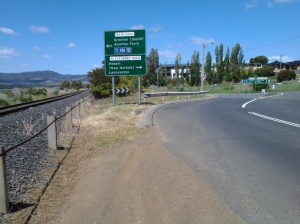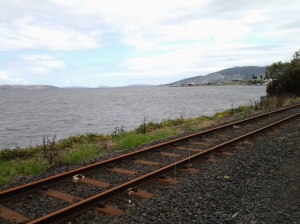I left home in Bellerive on the eastern shore of the Derwent River before 7am while the morning was cool and the light was soft grey. By the time my bus into Hobart city was travelling over the Tasman Bridge, the sun had hit the top of Mount Wellington, the sky was blue, and the day promised to be sensational. The dramatic circus tent on the Queens Domain was being dismantled. People on the bus seemed to be dozing. Yet outside the bus, I wondered at the stunning crispness of shadows and sunlight causing windows to sparkle. The look of the day made me feel like I was sparkling. But my eyes were wide open. Waiting at the bus stop at Franklin Square for a bus headed towards Kingston but passing through Taroona, all I could think was ‘glorious, glorious, glorious’.
With few people on board, the trip to bus stop 30 in Taroona (the one where I finished in Stage 11) only took 22 minutes and then I was out in the fresh air on the Channel Highway at 7.52am. Gulls calling. Gardens were flush with sunflowers, roses, agapanthus, wandering pumpkin plants, lavenders of all types, and flowering gum trees. All overlaid by the sounds of bush birds flitting here and there.
By 7.58am I had walked down Hinsby Street and reached the top of the walkway leading to the Hinsby Beach. I could hear the shushing of the soft waves along the beach and glimpse a tiny bit of water at the end of the shady path.

I could see the Alum Cliffs through the trees.

A swimmer was leaving the water as I clicked a photograph. When I registered his angry body language, I realised I had been feeling the place without really seeing. Of course my finger on the tablet’s camera clicked mechanically without seeing or feeling – but featuring photographs with him was not to his liking. I immediately claimed to be photographing the Alum Cliffs at the end of the beach and promised not to blog his picture.

I guess the swimmer was not used to sharing the beach with anybody else that early and could only repeat rather manically, ‘you must come in’, ‘you must come in’ as he gesticulated towards the water. I was thickly dressed from neck to toe and already wearing my sun hat. ‘Going in’ was not in my plan. I continued along the beach. A little later on a path, I took the following photo – I hope you can understand that getting undressed would never have been an option.

At 8.05am, at the end of Hinsby Beach, I looked back for one last sea-level view of Hinsby Beach.

I reached a stairway with rails and walked uphill until I seemed not to be on a clear track.

When you read further below you will realise the photo above does not show the start of the track which I should have taken.
Very soon I arrived at a gully with a small trickle of water passing downhill. I chose not to cross by balancing as a gymnast on the dead tree trunks that criss-crossed it. Instead I simply walked easily down, stepped across a few rocks and walked up the other side. Before long it was clear I was fenced in and that a proper dirt track passed on the other side of the fence. The fence was elastic so I swayed over it rather dramatically without falling off and down the cliff on the other side of the track. When I righted myself and looked back along the track which I hadn’t known existed, three women and a dog stood very still, their mouths agape. ‘Are you alright?’ they chorused. ‘Yes’, I assured them as I smiled. Some moments I wonder if I am losing my once good judgement. ‘But where have you come from?’ I asked with a puzzled wrinkling of my forehead. ‘Where did you find this track?’ Apparently, if I had bypassed the stairs and track I had chosen and walked around over the rocks of Hinsby Beach a little further, the real track started there. Time for the installation of a few signs!
This ‘new’ track was fine.

Although there were occasional diversions across the track.

The view back towards Hinsby Beach was clear.

The time was 8.22am as I offloaded my jacket, smeared sunscreen across exposed parts of my body and continued walking along the track until it extended up into a suburban street. At 8.25am I turned left into Wandella Ave, wandered along past houses for a while, could not see any further tracks back to the Alum Cliffs, talked to a local who did not think there was one and recommended that I should walk up to the Channel Highway and continue southwards on that road.
Not to be defeated, I retraced my steps down the original pathway until I discerned an old disused track that seemed to continue along the Cliffs. I walked it but casual inexperienced walkers and those walking alone absolutely should not. Incredibly unsafe in just about every way. I didn’t fall nor receive injuries but there were so many ways and places I could have damaged or killed myself on that route. I won’t relay all the details of that walk except to say that the views across the Derwent River though the trees were grand. Blue Wrens darted around me through the bush. Waves pounded against the Cliffs, and I could hear the roar of waves crashing on distant beaches. Because photographs flatten the vistas, the ones I have taken do not present the feeling of isolation, steepness nor roughness of this non-track. But it was incredibly beautiful and I am glad to have seen that landscape.

I started this diversion at 8.37am. After following a collapsing path (although parts were good), I managed a deep descent into and an ascent out of an unnamed gully by 9.12am, rounded an extensive private house, talked with the house owner about the future of tracks along the Alum Cliffs and the non-availability of any tracks passing his house (which stood on the very edge of the Cliff) around 9.25am, and walked down and around the very long winding private driveway over a trickling creek, I reached suburbia again at 9.35am – the same point on Wandella Ave I had been earlier in the morning. I had completed a loop. Certainly I had been close to the Derwent River more than most but I had not advanced along the River.
The first photo below shows the house I climbed up to on top of the cliff after descending into a gully, the waters of which plunged over a rocky edge to the River.



I recommend that all evidence of the existence of the disused track should be eliminated.
-42.955854
147.342752






























































































